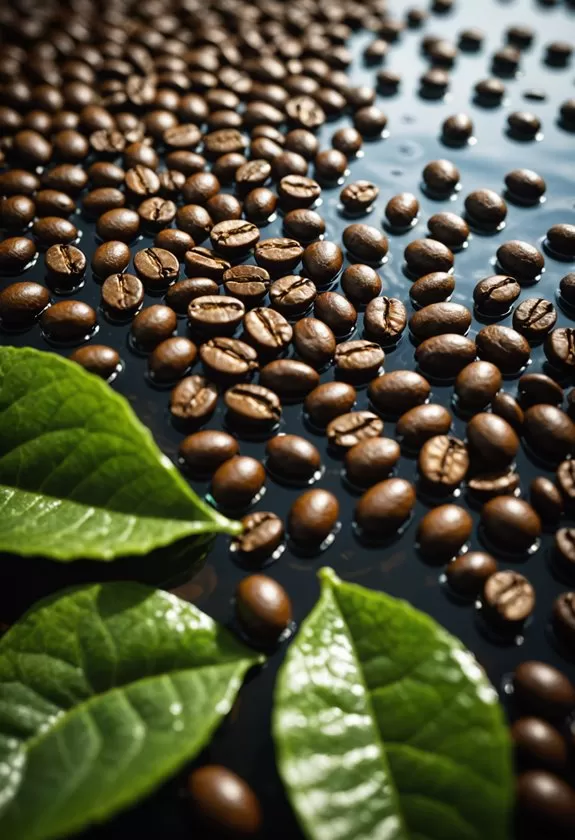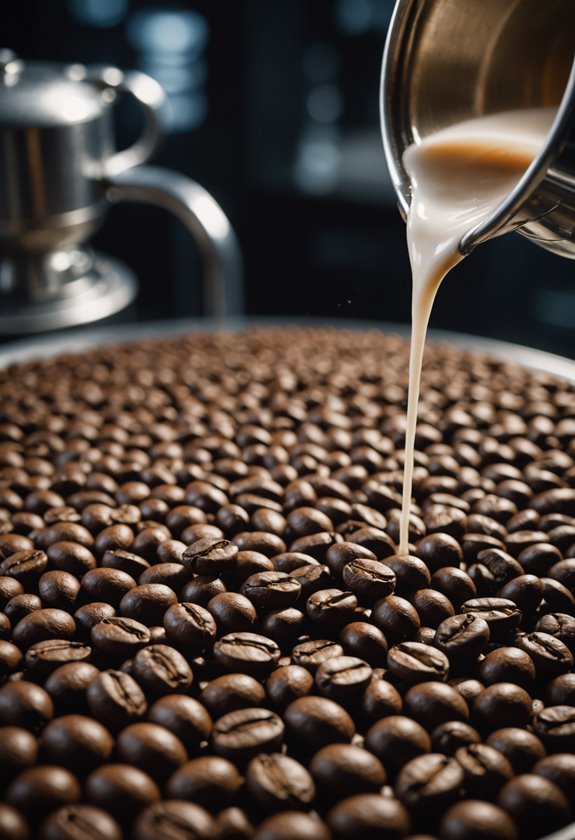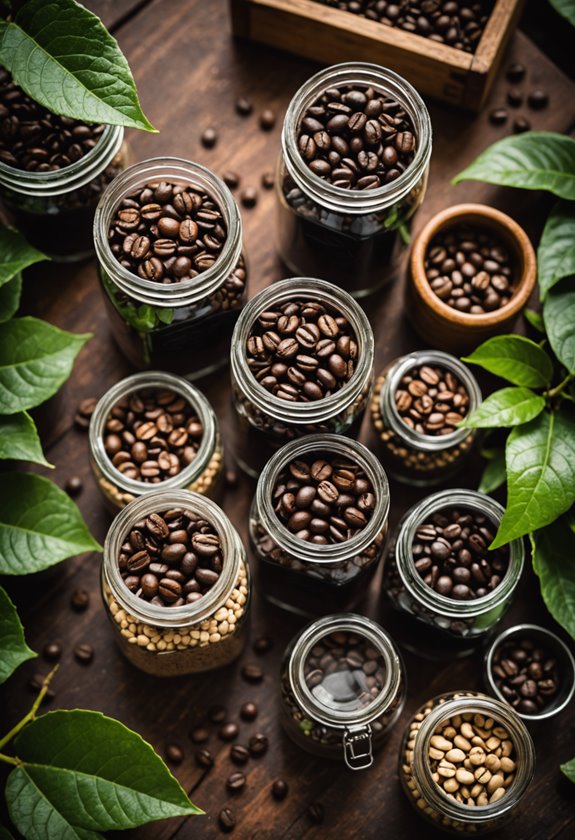How Do You Remove Caffeine From Coffee Beans?
You can remove caffeine from coffee beans using methods like the Swiss Water Process, Direct Solvent Method, Carbon Dioxide Technique, and Triglyceride Process. In the Swiss Water Process, beans soak in hot water, with caffeine filtered through carbon while flavor compounds remain intact. The Direct Solvent Method employs methylene chloride or ethyl acetate to capture caffeine during a steaming and rinsing sequence, ensuring flavor retention. The Carbon Dioxide Technique uses pressurized CO2 to selectively extract caffeine, preserving the beans' taste. Finally, the Triglyceride Process applies coffee oils to bind caffeine, allowing beans to recover their original flavors. Let's investigate how these methods shape your decaf coffee experience.
Summary of Key Findings
- The Swiss Water Process removes caffeine using hot water and a carbon filter, preserving flavor without chemicals.
- The Direct Solvent Method uses solvents like methylene chloride to extract caffeine, ensuring no harmful residues remain.
- The Carbon Dioxide Technique uses pressurized CO2 to selectively extract caffeine while maintaining flavor quality.
- The Triglyceride Process uses coffee oils to bind caffeine, reducing it while preserving original flavors.
- Each decaffeination method influences flavor intensity and aroma, affecting the coffee's overall taste.
The Swiss Water Process

The Swiss Water Process is one of the most popular methods for decaffeinating coffee beans without using chemicals. If you're looking for a natural way to enjoy your coffee, this method might just be your perfect match. Let's investigate how it works and its benefits.
Understanding the Process
In the Swiss Water Process, coffee beans are soaked in hot water to dissolve caffeine and flavor compounds. This water, now rich in flavor, is passed through a carbon filter that traps caffeine molecules. Similar to Illy Decaffeinated Whole Bean coffee, this technique ensures full flavor retention while removing caffeine.
The flavor-rich, caffeine-free water, known as Green Coffee Extract (GCE), is used to soak another batch of beans, allowing them to maintain their taste while losing caffeine. It's a gentle, chemical-free process, making it unique in decaffeination history.
Swiss Benefits
Choosing the Swiss Water Process offers several benefits. It preserves the intricate flavors of your favorite coffee, letting you enjoy the full-bodied taste without the jitters.
Additionally, it's environmentally friendly, aligning with a more sustainable lifestyle. You can savor each sip, knowing your coffee hasn't been exposed to harsh chemicals.
Accept this method for a purer, more authentic coffee experience.
Much like Miele Black Edition beans, this process helps maintain the coffee's premium quality and rich flavor characteristics.
Direct Solvent Method
While the Swiss Water Process offers a chemical-free decaffeination method, some might prefer the efficiency of the Direct Solvent Method. This approach involves using solvents like methylene chloride or ethyl acetate to remove caffeine directly from coffee beans. It's an effective way to achieve caffeine extraction, especially if you're looking for a quick and straightforward method. Similar to how Folgers Classic Roast maintains its rich flavor profile through careful processing, this method preserves the coffee's original taste characteristics. Like trusted coffee brands, this method has proven reliable for consistent quality and results.
How It Works
1. Steaming
The beans are steamed to open their pores.
2. Solvent Application
Solvent is applied to dissolve the caffeine.
3. Rinsing
Beans are rinsed to remove caffeine and solvent.
4. Drying
Beans are dried to remove moisture.
5. Roasting
Coffee beans are roasted as usual.
Let's investigate why this method is favored by some. The direct method allows caffeine to be extracted efficiently, keeping much of the beans' original flavor intact.
Though the idea of using chemicals might sound intimidating, rest assured that the solvents evaporate completely during the process, leaving no residue.
You might find that this method meets your needs if you prioritize speed and flavor retention. The direct method, with its precise caffeine extraction, guarantees you can enjoy a decaf coffee that still feels like the real deal.
Carbon Dioxide Technique

Opt for the Carbon Dioxide Technique if you're seeking a modern and environmentally friendly way to decaffeinate coffee beans. This method, known for its innovative approach, uses carbon dioxide extraction, offering a cleaner alternative to traditional methods. You might wonder how it all works. Let's examine.
How It Works
In carbon dioxide extraction, you immerse the coffee beans in water, softening them.
Then, you expose them to pressurized carbon dioxide in a sealed chamber. The pressure alters carbon dioxide into a supercritical fluid, meaning it acts like both a liquid and a gas.
This fluid selectively targets caffeine molecules, leaving other flavor elements intact. The caffeine removal process guarantees that the beans retain their rich aroma and taste.
Benefits
What makes this technique so appealing is its eco-friendly nature.
Carbon dioxide is a natural, non-toxic gas, which means it doesn't leave harmful residues on the beans.
Plus, the carbon dioxide used can be recycled, making the process sustainable.
Much like Lavazza Super Crema blend, this process helps maintain the coffee's aromatic notes and smooth finish.
Final Thoughts
If you're keen on preserving the original flavors of your coffee while minimizing environmental impact, this method could be your perfect match.
It's a sophisticated way to enjoy your decaf without compromising on taste or the planet.
The Triglyceride Process
Looking for another way to decaffeinate coffee while maintaining its authentic taste? Let's examine the triglyceride process, a unique method that cleverly employs natural oils. It starts with soaking coffee beans in hot water to extract caffeine and other soluble components. This step creates a caffeine-laden solution, which plays a crucial role in the next phase.
Triglyceride Extraction
The magic of triglyceride extraction begins with mixing this solution with coffee oils, often derived from used coffee grounds. Triglycerides—complex molecules found in these oils—are the stars here, binding to caffeine molecules.
Through this process, caffeine is effectively reduced from the mix. Once the oils have captured the caffeine, the beans are reintroduced to the solution. This allows them to reabsorb their original flavor compounds, minus the caffeine, preserving their pleasing taste.
Caffeine Reduction
The triglyceride process provides an efficient caffeine reduction, ensuring that your coffee retains its rich, aromatic character. This method accepts a more natural approach, avoiding the use of synthetic chemicals, making the final product appealing for those who prioritize both flavor and natural processing.
Comparing Flavor Profiles

When comparing flavor profiles of decaffeinated coffee, you'll find that the method of caffeine removal considerably influences taste. Each technique impacts the flavor intensity and aroma characteristics, shaping your coffee experience.
Let's investigate how these methods differ.
Swiss Water Process
This chemical-free method excels in preserving flavor intensity. By using only water, it keeps the integrity of the bean's natural flavors intact.
You'll notice a smooth, rich taste, with aroma characteristics that remain lively and inviting. It's ideal for those who prefer a purer coffee experience.
Carbon Dioxide Method
This method uses carbon dioxide to extract caffeine, maintaining a balance between flavor and aroma.
It preserves most of the bean's original profile, offering a pleasant, well-rounded cup. The flavor intensity is mild compared to the Swiss Water Process but still satisfying.
Solvent-Based Method
Involving chemicals like methylene chloride, this method can slightly alter flavor intensity.
It might lead to a less hearty taste, but some drinkers appreciate its subtlety. Aroma characteristics can be muted, offering a gentler coffee experience.
Understanding these differences helps you choose a decaf coffee that suits your palate perfectly. Each method holds its charm, offering a unique coffee expedition.
Frequently Asked Questions
Is Decaffeinated Coffee Completely Caffeine-Free?
You might think decaf coffee is completely caffeine-free, but that's a common decaf misconception. Even after processing, caffeine levels remain slightly present. You'll enjoy a much lower caffeine content, but it's not entirely caffeine-free.
How Long Does the Decaffeination Process Typically Take?
You might wonder how long it takes to decaffeinate coffee. Typically, decaffeination methods take several hours. The processing timeline depends on the method used, but you'll often find it ranges from 8 to 12 hours.
Are There Health Risks Associated With Decaffeinated Coffee?
You might wonder about decaf's health risks, but there's good news. It often provides health benefits, especially if you've caffeine sensitivity. So, cozy up with your cup, knowing it's generally safe and beneficial.
Does Decaffeination Affect the Nutritional Content of Coffee?
You might wonder if decaffeination affects coffee's nutritional benefits. It can slightly alter some compounds, but you'll still get antioxidants. For caffeine alternatives, adopt herbal teas or chicory for a comforting, intimate experience without missing coffee's warmth.
Can Decaffeinated Coffee Spoil or Expire Faster Than Regular Coffee?
You might wonder if decaf freshness fades quicker than regular coffee. It can, so always store your decaf in airtight containers away from moisture and light. These storage tips help keep it delicious longer. Enjoy your brew!
Conclusion
You've now investigated four fascinating methods for removing caffeine from coffee beans: the Swiss Water Process, the Direct Solvent Method, the Carbon Dioxide Technique, and the Triglyceride Process. Each method offers a unique approach, affecting the coffee's flavor differently. Understanding these techniques helps you appreciate your morning brew even more. So, next time you sip decaf, remember the science behind it and savor the rich, flavorful experience that careful decaffeination can bring.







